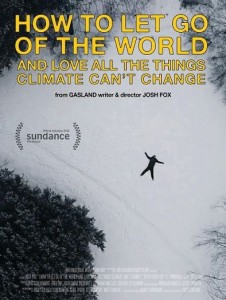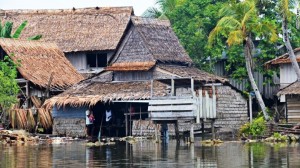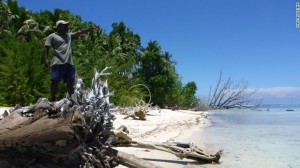Five Pacific islands lost to sea level rise
 In April, the 6th Annual Fort Myers Film Festival screened a documentary filmed by Josh Fox titled from How to Let Go of the World and Love All the Things Climate Can’t Change. The film included a clip where Pacific Islanders from nations including the Marshall Islands, Fiji, Vanuatu and the Solomon Islands set out in hand-carved canoes to blockade one of the world’s largest coal ports in Newcastle, Australia chanting, “We are not drowning, we are fighting.” This week the world learned that five tiny islands in the Soloman Archipelago have disappeared amid rising seas and erosion.
In April, the 6th Annual Fort Myers Film Festival screened a documentary filmed by Josh Fox titled from How to Let Go of the World and Love All the Things Climate Can’t Change. The film included a clip where Pacific Islanders from nations including the Marshall Islands, Fiji, Vanuatu and the Solomon Islands set out in hand-carved canoes to blockade one of the world’s largest coal ports in Newcastle, Australia chanting, “We are not drowning, we are fighting.” This week the world learned that five tiny islands in the Soloman Archipelago have disappeared amid rising seas and erosion.
While these five islands were not inhabited by human beings, six  other islands in the Archipelago saw swathes of land turn into sea, destroying entire villages. One of the six islands that has been heavily eroded is Nuatambu Island, home to 25 families. It has lost 11 houses and half its inhabitable area since 2011.
other islands in the Archipelago saw swathes of land turn into sea, destroying entire villages. One of the six islands that has been heavily eroded is Nuatambu Island, home to 25 families. It has lost 11 houses and half its inhabitable area since 2011.
The Solomon Islands is a nation made up of  hundreds of islands. It has a population of about 640,000. The archepelago lies about 1,000 miles north-east of Australia.
hundreds of islands. It has a population of about 640,000. The archepelago lies about 1,000 miles north-east of Australia.
The study, published in online journal Environmental Research Letters, looked at 33 islands using aerial and satellite imagery from  1947 to 2014, combined with historical insight and local knowledge. It found that the archipelago had seen sea levels rise as much as 0.4 inches every year for the past two decades. The five islands that have vanished were all vegetated reef islands ranging from 2.5 up to 12 acres in size that were
1947 to 2014, combined with historical insight and local knowledge. It found that the archipelago had seen sea levels rise as much as 0.4 inches every year for the past two decades. The five islands that have vanished were all vegetated reef islands ranging from 2.5 up to 12 acres in size that were  occasionally used by fishermen but not populated.
occasionally used by fishermen but not populated.
The researchers say their study is the first that scientifically “confirms the numerous anecdotal accounts from across the Pacific of the dramatic impacts of climate change on coastlines and people.” However, the report emphasized that  other factors besides rising sea levels contributed to the loss of the islands. For example, it found that shoreline recession was substantially worse in areas exposed to high wave energy, and that extreme events and inappropriate development were also factors contributing to the erosion.
other factors besides rising sea levels contributed to the loss of the islands. For example, it found that shoreline recession was substantially worse in areas exposed to high wave energy, and that extreme events and inappropriate development were also factors contributing to the erosion.
 Some communities are already adapting to the changed conditions. Several Nuatambu islanders have moved to a higher neighboring volcanic island, the study said. Other people were forced to move on the island of Nararo.
Some communities are already adapting to the changed conditions. Several Nuatambu islanders have moved to a higher neighboring volcanic island, the study said. Other people were forced to move on the island of Nararo.
One of them, 94-year-old Sirilo Sutaroti, told researchers: “The sea has started to come inland, it forced us to move up to the hilltop and rebuild our village there away from the sea.”
 Taro, the capital of Choiseul Province, is set to become the first provincial capital to relocate residents and services.
Taro, the capital of Choiseul Province, is set to become the first provincial capital to relocate residents and services.
In April, the Solomon Islands was among the 177 nations that signed a global agreement reached in Paris to curb climate change.
“’We are not drowning, we are fighting’ could be an anthem for New Yorkers, for Philadelphians, for people in San Francisco and Miami,” Fox pointed out via Skype to the FMff audience in April. “A lot of times when you talk about climate change, you don’t know how to fight. But what we’re going to do with this film, before it goes on HBO in the summertime, is tour it all across America to a hundred of the  hotspots, like you see in the Port of Newcastle, but in America, where people are fighting pipelines and power plants, compressor stations, LNG terminals, mountaintop removal, fracking, tar sands—all the places where the fossil fuel industry is invading America. That’s called the Let Go and Love Tour, where we work directly with
hotspots, like you see in the Port of Newcastle, but in America, where people are fighting pipelines and power plants, compressor stations, LNG terminals, mountaintop removal, fracking, tar sands—all the places where the fossil fuel industry is invading America. That’s called the Let Go and Love Tour, where we work directly with  communities to provide them with renewable energy alternatives on the ground and also mobilize. So, you can learn more about that at our Facebook page, or we actually are running a Kickstarter campaign to help us get all across America.
communities to provide them with renewable energy alternatives on the ground and also mobilize. So, you can learn more about that at our Facebook page, or we actually are running a Kickstarter campaign to help us get all across America.
The Paris Accord notwithstanding, the documentary acknowledges that it is already too late to stave off many of the worst effects  resulting from the greenhouse gases that are produced when fossil fuels like coal and oil are burned. While many scientists warn of dire consequences if average annual temperatures rise by more than 2 degrees Celsius, new research that factors in the collapsing Antarctic ice sheet suggests that the sea levels will rise by more than six feet by the year 2100 even if emissions are cut by the amounts
resulting from the greenhouse gases that are produced when fossil fuels like coal and oil are burned. While many scientists warn of dire consequences if average annual temperatures rise by more than 2 degrees Celsius, new research that factors in the collapsing Antarctic ice sheet suggests that the sea levels will rise by more than six feet by the year 2100 even if emissions are cut by the amounts  specified in the Paris agreement. This conclusion is buttressed by the fact that in Greenland, the huge Zachariae Isstrom glacier has begun to break up, starting a rapid retreat that could continue to raise sea levels for decades to come
specified in the Paris agreement. This conclusion is buttressed by the fact that in Greenland, the huge Zachariae Isstrom glacier has begun to break up, starting a rapid retreat that could continue to raise sea levels for decades to come
Looking at these developments, at least one climatologist thinks catastrophe is inevitable, carbon offsetting is a joke and ethical living a scam. “Enjoy life while you can: in 20 years, global  warming will hit the fan,” states climate science maverick James Lovelock somberly.
warming will hit the fan,” states climate science maverick James Lovelock somberly.
There are no federal, state or local protocols or initiatives to plan for anticipated sea level rise in Lee County, including low lying areas such as the downtown Fort Myers River District, Sanibel, Matlacha, Pine Island or Fort Myers Beach.














 Tom Hall is both an amateur artist and aspiring novelist who writes art quest thrillers. He is in the final stages of completing his debut novel titled "Art Detective," a story that fictionalizes the discovery of the fabled billion-dollar Impressionist collection of Parisian art dealer Josse Bernheim-Jeune, thought by many to have perished during World War II when the collection's hiding place, Castle de Rastignac in southern France, was destroyed by the Wehrmacht in reprisal for attacks made by members of the Resistance operating in the area. A former tax attorney, Tom holds a bachelor's degree as well as both a juris doctorate and masters of laws in taxation from the University of Florida. Tom lives in Estero, Florida with his fiancee, Connie, and their four cats.
Tom Hall is both an amateur artist and aspiring novelist who writes art quest thrillers. He is in the final stages of completing his debut novel titled "Art Detective," a story that fictionalizes the discovery of the fabled billion-dollar Impressionist collection of Parisian art dealer Josse Bernheim-Jeune, thought by many to have perished during World War II when the collection's hiding place, Castle de Rastignac in southern France, was destroyed by the Wehrmacht in reprisal for attacks made by members of the Resistance operating in the area. A former tax attorney, Tom holds a bachelor's degree as well as both a juris doctorate and masters of laws in taxation from the University of Florida. Tom lives in Estero, Florida with his fiancee, Connie, and their four cats.